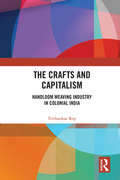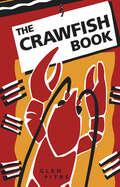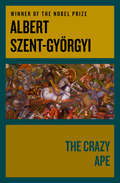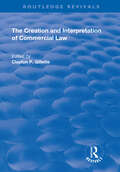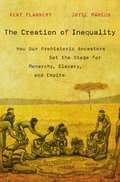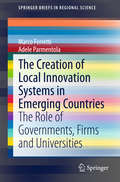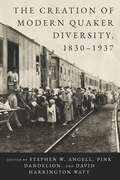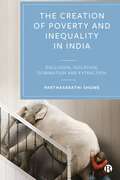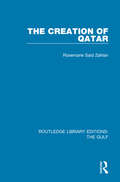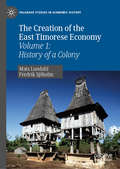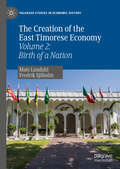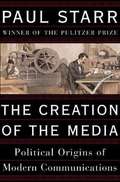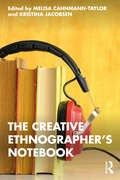- Table View
- List View
The Crafting of the Postwar Peace Treaty with Japan, 1945–1951 (Routledge Studies in the Modern History of Asia)
by Seung Mo KangThis book examines how the Treaty of Peace with Japan, a momentous agreement that delineated postwar order in the Pacific, was negotiated between Japan and 48 other nations in 1951.Even though the treaty was created to legally end the state of war between Japan and its Pacific War enemies, many other considerations - some of which had hardly anything to do with the Pacific War - were involved. The US-Soviet rivalry was the most representative, but this was not the only factor. For instance, the decision to invite Cambodia, Laos and Vietnam as signatories was determined based on French colonial interests, Indochinese yearning for independence and the need for French contribution in the North Atlantic Treaty Organization. Similarly, German reparations settlements after the First and Second World Wars impacted Japanese reparations settlement. Meanwhile, the commercial terms of the treaty were informed by the Great Depression and its legacies. This book addresses these aspects of the peace treaty that are hitherto not sufficiently elaborated upon in existing studies.Highlighting the importance of the treaty for shaping postwar East Asia and international relations in the region to the present day, this book will be a valuable resource for students and scholars of post-war Japan, International relations, and the Cold War.
The Crafts and Capitalism: Handloom Weaving Industry in Colonial India
by Tirthankar RoyThis book presents a comprehensive history of handloom weaving industry in India to challenge and revise the view that competition from machine-produced textiles destroyed the country’s handicrafts as claimed by historians until recently. It shows that skill-intensive handmade textiles survived the competition on a large scale, and that handmade goods and high-quality manual labour played a positive role in the making of modern India. Rich in archival material, The Crafts and Capitalism explores themes such as the historiography of craft technologies; statistical work on nineteenth-century cotton cloth production trends; narratives of merchants, the social leaders, the factory-owners; tools and techniques; and, shift from handloom to power loom. The book argues that changes in the handloom industry were central to the consolidation of new forms of capitalism in India. An important intervention in Indian economic history, this book will be useful to scholars and researchers of Indian history, economic history, colonial history, modern history, political history, labour history and political economy. It will also interest nongovernmental organizations, textile historians, and design specialists.
The Crawfish Book
by Glen PitreAmerican Indians worshiped them as creators of the world, Napoleon ate them to celebrate his victories, Swedes have them shipped in from halfway around the world, and for Louisiana's Cajuns the humble crawfish is the centerpiece of cuisine, a symbol of ethnic pride, a staple commodity for thriving business ventures, and an inextricable part of folklore. Research and interviews spice this delightful book that details the relationship between crawfish and humans—from antiquity to the New York markets of the 1880s; from Depression-era pauper's feast to gourmet entree of the 1980s Cajun cooking craze; from spring afternoon pastime to modern aquaculture agribusiness. To get the reader's mouth watering, more than two dozen recipes from those who know crawfish best—both famous chefs and crawfishers—are interspersed throughout. Sections offer advice on catching, buying, handling, cooking, and, for those who wish to simplify their encounters with crawfish, ordering tasty dishes in restaurants. Included are also a bibliographical essay, an index to recipes, and a list of sources for spices, paraphernalia, and airfreight shipments of crawfish.
The Crazy Ape: Written by a Biologist for the Young
by Albert Szent-GyörgyiA Nobel Prize winner, Dr. Szent-Györgyi concerns himself with the underlying forces and conditions that have prevented the realization of the higher possibilities of the American Dream, and, by extension, of all mankind. He addresses himself especially to the youth of the world in his attempt to show how man, the more he progresses technologically, seems the more to regress psychologically and socially, until he resembles his primate ancestors in a state of high schizophrenia. The fundamental question asked by this book is: why is it that most of the scientific research that is done to elevate human life serves in the end to destroy it? That this phenomenon exists is unarguable. How to alter it is the problem the author tackles. He finds the possibility, indeed the instrument of our survival, in our youth. Dr. Szent-Györgyi calls upon the youth the world over to organize and exercise their power to create a new world. He implores them not to waste their energies in petulance and frustration—the world is ripe for the radical changes needed for man&’s survival, and for youth to fritter away their opportunity would be to compound the tragedy and seal the fate of mankind.
The Crazy Ape: Written by a Biologist for the Young
by Albert Szent-GyörgyiA Nobel Prize winner, Dr. Szent-Györgyi concerns himself with the underlying forces and conditions that have prevented the realization of the higher possibilities of the American Dream, and, by extension, of all mankind. He addresses himself especially to the youth of the world in his attempt to show how man, the more he progresses technologically, seems the more to regress psychologically and socially, until he resembles his primate ancestors in a state of high schizophrenia. The fundamental question asked by this book is: why is it that most of the scientific research that is done to elevate human life serves in the end to destroy it? That this phenomenon exists is unarguable. How to alter it is the problem the author tackles. He finds the possibility, indeed the instrument of our survival, in our youth. Dr. Szent-Györgyi calls upon the youth the world over to organize and exercise their power to create a new world. He implores them not to waste their energies in petulance and frustration—the world is ripe for the radical changes needed for man&’s survival, and for youth to fritter away their opportunity would be to compound the tragedy and seal the fate of mankind.
The Crazy Wisdom of Ganesh Baba: Psychedelic Sadhana, Kriya Yoga, Kundalini, and the Cosmic Energy in Man
by Eve Baumohl NeuhausThe core teachings and riotous life of the psychedelic yogi Ganesh Baba • Presents the teachings of Ganesh Baba’s “Crea” Yoga, which he derived from the tantric practices of traditional Kriya Yoga • Explains the basic exercises for following the Crea (creative) Yoga practice • Includes many anecdotes from the colorful life of this “psychedelic” baba Shri Mahant Swami Ganeshanand Saraswati Giri (ca. 1895-1987) was known to all who loved and studied with him simply as Ganesh Baba. At the age of four, he was brought back from death through an initiation by Lahiri Mahasaya and through this initiation descends from the same Kriya Yoga lineage as Paramahansa Yogananda. He became a swami under his guru Sivananda and later went on to run the Anandamayi Ma ashram. Drawn to the life of the Naga Babas, he became the head of the Ananda Akhara, Naga followers of Lord Shiva who consider cannabis and other entheogens to be the gift of the gods. The unique set of principles and exercises Ganesh Baba developed from the tantric practices of traditional Kriya Yoga and Shivaism became the core of his personal teachings of Crea (for creative) Yoga. Ganesh Baba’s message of systematic synthesis of the spiritual and secular was carefully developed for and embraced by contemporary students in the 1960s, especially those whose path included the use of entheogens. This book contains the core of Ganesh Baba’s Crea Yoga teachings, from the beginning stages of conscious control of one’s posture, breath, and attention to finally extending one’s awareness to the farthest reaches of the cosmos. Eve Baumohl Neuhaus shows that the life of this scholar and crazy saint was as instructive as his teachings. She includes many personal reminiscences of this inspirational and challenging teacher from her own life and those of fellow students, which demonstrate that Ganesh Baba’s extraordinary life was in keeping with his own role as the embodiment of Lord Ganesh, the remover of obstacles.
The Creation and Interpretation of Commercial Law
by Clayton P. GilletteThis title was first published in 2003. This volume contains essays by prominent commentators on topics in commercial law. It addresses the increasing harmonization of international commercial law and the essays demonstrate different methodologies used in analysing commercial law, such as economic and jurisprudential approaches.
The Creation of Anne Boleyn: A New Look at England's Most Notorious Queen
by Susan BordoThis illuminating history examines the life and many legends of the 16th century Queen who was executed by her husband, King Henry VIII. Part biography, part cultural history, The Creation of Anne Boleyn is a fascinating reconstruction of Anne&’s life and a revealing look at her afterlife in the popular imagination. Why is her story so compelling? Why has she inspired such extreme reactions? Was she the flaxen-haired martyr of Romantic paintings or the raven-haired seductress of twenty-first-century portrayals? (Answer: neither.) But the most provocative question of all concerns Anne&’s death: How could Henry order the execution of a once beloved wife? Drawing on scholarship and critical analysis, Bordo probes the complexities of one of history&’s most infamous relationships. She then demonstrates how generations of polemicists, biographers, novelists, and filmmakers have imagined and re-imagined Anne: whore, martyr, cautionary tale, proto &“mean girl,&” feminist icon, and everything in between. In The Creation of Anne Boleyn, Bordo steps off the well-trodden paths of Tudoriana to tease out the human being behind the competing mythologies, paintings, and on-screen portrayals.
The Creation of Dangerous Violent Criminals
by Lonnie H AthensLonnie H. Athens’ path-breaking work examines a problem that has baffled experts and the general public alike: How does a person become a predatory violent criminal? In the original edition, the process that Athens labeled “violentization” encompassed four stages: brutalization, defiance, dominative engagements, and virulency. In this edition, Athens identifies a new final stage, violent predation, as the culmination of the violent criminal’s development. He uses vivid first-person accounts gleaned from in-depth interviews and participant observation of nascent and hardened violent criminals to back up his theory. In this vastly expanded edition, Athens examines how his thinking and ideas have evolved over the past thirty years and renames and clarifies two stages of development. Athens also addresses, for the first time, criticisms of his original theory. Milestones of this important work are discussed, as well as the paradoxes surrounding its present-day status in the field of criminology. Athens proposes a revised theoretical model that will be useful for classroom use, as well as for interested general readers and professionals.
The Creation of Feminist Consciousness: From the Middle Ages to Eighteen-Seventy (Women and History, Volume #2)
by Gerda LernerLerner studies how women have been affected, marginalized, by the construction of recorded History -- as differentiated from history -- the events of the past and the devastating impact of educational deprivation. This is not a superficial rehash of the arguments for women's studies. Both general and scholarly readers will find Lerner's explication to be powerful and important.
The Creation of Inequality: How Our Prehistoric Ancestors Set the Stage for Monarchy, Slavery, and Empire
by Kent Flannery Joyce MarcusOur early ancestors lived in small groups and worked actively to preserve social equality. As they created larger societies, however, inequality rose, and by 2500 BCE truly egalitarian societies were on the wane. In The Creation of Inequality, Kent Flannery and Joyce Marcus demonstrate that this development was not simply the result of population increase, food surplus, or the accumulation of valuables. Instead, inequality resulted from conscious manipulation of the unique social logic that lies at the core of every human group. A few societies allowed talented and ambitious individuals to rise in prestige while still preventing them from becoming a hereditary elite. But many others made high rank hereditary, by manipulating debts, genealogies, and sacred lore. At certain moments in history, intense competition among leaders of high rank gave rise to despotic kingdoms and empires in the Near East, Egypt, Africa, Mexico, Peru, and the Pacific. Drawing on their vast knowledge of both living and prehistoric social groups, Flannery and Marcus describe the changes in logic that create larger and more hierarchical societies, and they argue persuasively that many kinds of inequality can be overcome by reversing these changes, rather than by violence.
The Creation of Local Innovation Systems in Emerging Countries
by Marco Ferretti Adele ParmentolaThis book deals with the creation of local innovation systems (LIS) in emerging countries. The authors analyze the role of the government, firms and research centers in the formation of LIS. Special attention is paid to the manner in which different leading actors implement their LIS development strategies. The book presents detailed case studies on different strategies used to implement LIS in Singapore, Dubai, Taiwan and Iran.
The Creation of Modern Quaker Diversity, 1830–1937 (The New History of Quakerism)
by Stephen W. Angell, Pink Dandelion, and David Harrington WattThe period from 1830 to 1937 was transformative for modern Quakerism. Practitioners made significant contributions to world culture, from their heavy involvement in the abolitionist and women’s rights movements and creation of thriving communities of Friends in the Global South to the large-scale post–World War I humanitarian relief efforts of the American Friends Service Committee and Friends Service Council in Britain.The Creation of Modern Quaker Diversity, 1830–1937 explores these developments and the impact they had on the Quaker religion and on the broader world. Chapters examine the changes taking place within the denomination at the time, including separations, particularly in the United States, that resulted in the establishment of distinct branches, and a series of all-Quaker conferences in the early twentieth century that set the agenda for Quakerism. Written by the leading experts in the field, this engaging narrative and penetrating analysis is the authoritative account of this period of Quaker history. It will appeal to scholars and lay Quaker readers alike and is an essential volume for meeting libraries. In addition to the editors, the contributors include Joanna Clare Dales, Richard Kent Evans, Douglas Gwyn, Thomas D. Hamm, Robynne Rogers Healey, Julie L. Holcomb, Sylvester A. Johnson, Stephanie Midori Komashin, Emma Jones Lapsansky, Isaac Barnes May, Nicola Sleapwood, Carole Dale Spencer, and Randall L. Taylor.
The Creation of Poverty and Inequality in India: Exclusion, Isolation, Domination and Extraction
by Parthasarathi ShomePoverty in India is intimately connected with caste, untouchability, colonialism and indentured servitude, inseparable from the international experience of slavery and race. Focusing on historical and modern practices, this book goes beyond traditional economic approaches to poverty and demonstrates its genesis in exclusion, isolation, domination and extraction resulting in the removal of human and economic rights. Examining cash and asset transfers, as well as the enhancement of women’s rights, primary health and education, it scrutinizes inadequacies in compensatory policies for redressing the balance. This is an original interdisciplinary contribution that offers bold domestic and international policies anchored in human radicalism to eradicate poverty.
The Creation of Qatar (Routledge Library Editions: The Gulf #4)
by Rosemarie Said ZahlanThis book, first published in 1979, was the first political and social history of Qatar. Its main thrust is to provide the reader with a description and identification of the processes and forces that have contributed to change and continuity in Qatari society. A concise and relevant history of the country from the latter part of the eighteenth century when the Utub settled Zubarah to the present day is provided. Emphasis is placed not only on Qatar’s internal development, but also on its critical relationship with Bahrain and Saudi Arabia, its closest neighbours, and with Britain. The study then proceeds to determine the inner logic of the Qatari political and social structure, and how it has evolved over the years. It is shown how the same society that exhibited great fortitude in the face of economic and political hardship could have an equally great capacity to adapt to new levels of prosperity.
The Creation of the East Timorese Economy: Volume 1: History of a Colony (Palgrave Studies in Economic History)
by Mats Lundahl Fredrik SjöholmThis two-volume study explores the economy of East Timor, of which very little has been written since the country gained independence in 2002. Currently, no comprehensive account exists of the economic history of the country. The former cannot be properly understood without a knowledge of the historical process that created the present-day situation. This research monograph is the first book to combine a historical analysis of the creation and development of the economy of East Timor from the earliest times to the present, and an analysis of the main contemporary problems facing the East Timorese economy. Volume I considers East Timor from a chronological perspective, as an occupied country up to the point at which Indonesia leave.This book will appeal to scholars and students of economics, political and social science. It will also be of interest to practitioners in these fields as it focuses on down-to-earth problems that need to be solved for the economy to develop.
The Creation of the East Timorese Economy: Volume 2: Birth of a Nation (Palgrave Studies in Economic History)
by Mats Lundahl Fredrik SjöholmVery little has been written on the economy of East Timor since the country’s independence in 2002, and no comprehensive account exists of the economic history of the country. The former cannot be properly understood without a knowledge of the historical process that created the present-day situation. This research monograph is the first book to combine a historical analysis of the creation and development of the economy of East Timor from the earliest times to the present, and an analysis of the main contemporary problems facing the East Timorese economy. Volume II offers a detailed analysis of the economy of East Timor, of politics, fiscal policy and social progress. It pays particular attention to structural problems: employment generation and the lack of a modern sector, the modernization of agriculture and the management of the oil deposits in the Timor Sea. The first volume, available separately, considers East Timor from a chronological perspective, as a Portuguese colony, and a country occupied by Indonesia up to national independence in 2002. This book will appeal to economists, political scientists and social scientists in general as well as practitioners, since it focuses on down-to-earth problems that need to be solved for the economy to develop. The book can also be read by students both at the undergraduate and graduate levels and could be used for case studies in development.
The Creation of the Media: Political Origins of Modern Communications
by Paul StarrAmerica's leading role in today's information revolution may seem simply to reflect its position as the world's dominant economy and most powerful state. But by the early nineteenth century, when the United States was neither a world power nor a primary center of scientific discovery, it was already a leader in communications-in postal service and newspaper publishing, then in development of the telegraph and telephone networks, later in the whole repertoire of mass communications.<P><P> In this wide-ranging social history of American media, from the first printing press to the early days of radio, Paul Starr shows that the creation of modern communications was as much the result of political choices as of technological invention. His original historical analysis reveals how the decisions that led to a state-run post office and private monopolies on the telegraph and telephone systems affected a developing society. He illuminates contemporary controversies over freedom of information by exploring such crucial formative issues as freedom of the press, intellectual property, privacy, public access to information, and the shaping of specific technologies and institutions. America's critical choices in these areas, Starr argues, affect the long-run path of development in a society and have had wide social, economic, and even military ramifications. The Creation of the Media not only tells the history of the media in a new way; it puts America and its global influence into a new perspective.
The Creation of the Zulu Kingdom, 1815-1828
by Elizabeth A. EldredgeThis scholarly account traces the emergence of the Zulu Kingdom in South Africa in the early nineteenth century, under the rule of the ambitious and iconic King Shaka. In contrast to recent literary analyses of myths of Shaka, this book uses the richness of Zulu oral traditions and a comprehensive body of written sources to provide a compelling narrative and analysis of the events and people of the era of Shaka's rule. The oral traditions portray Shaka as rewarding courage and loyalty and punishing failure;
The Creative Animal: How Every Animal Builds its Own Existence
by Roberto MarchesiniThis book deals with the theme of creativity in the animal world, conceived as a basic function for adapting to specific situations and as a source of innovations and inventions. Creativity is a fundamental resource for the individual who always has a leading role in conduct. To explain creativity, the book focuses on the concept of animal subjectivity, providing a new explanatory model of behavior capable of overcoming the image of the animal moved by automatisms. This model does not use consciousness as a necessary condition, but is based: 1) on affective components, such as behavioral motives, and 2) cognitive, as tools used by the subject to carry out his purposes. Particular attention is paid to the learning processes showing the subjective character of the experience. One topic addressed is the role of creativity in the evolution of living beings: how an invention, by modifying the niche characteristics, is able to change the selective pressures and the trajectory of phylogeny. Roberto Marchesini explains that creativity is a factor that is anything but rare or exceptional in the animal world—it constitutes a fundamental quality for many aspects of animal life.
The Creative Ethnographer's Notebook
by Cahnmann-Taylor, Edited by MelisaThe Creative Ethnographer's Notebook offers emerging and trained ethnographers exercises to spark creativity and increase the impact and beauty of ethnographic study.With contributions by emerging scholars and leading creative ethnographers working in various social science fields (e.g., anthropologists, educators, ethnomusicologists, political scientists, geographers, and others), this volume offers readers a variety of creative prompts that ethnographers have used in their own work and university classrooms to deepen their ethnographic and artistic practice. The contributions foreground different approaches in creative practice, broadening the tools of multimodal ethnography as one designs a study, works with collaborators and landscapes, and renders ethnographic findings through a variety of media. Instructors will find dozens of creative prompts to use in a wide variety of classroom settings, including early beginners to experienced ethnographers and artists. In the eBook+ version of this book, there are numerous pop-up definitions to key ethnographic terms, links to creative ethnographic examples, possibilities for extending prompts for more advanced anthropologists, and helpful tips across all phases of inquiry projects.This resource can be used by instructors of anthropology and other social sciences to teach students how to experiment with creative approaches, as well as how to do better public and engaged anthropology. Artists and arts faculty will also benefit from using this book to inspire culturally attuned art making that engages in research, as well as research-based art. Readers will learn how creative ethnography draws on aspects of the literary, visual, sonic, and/or performing arts. Information is provided about how scholars and artists, or scholartists, document culture in ways that serve more diverse public and academic audiences.
The Creative Industries: Culture and Policy
by Terry Flew"Moving from age-old warnings about the influence of the cultural industry to a tentative embrace of a global creative society, Terry Flew's new book provides an excellent overview of this exciting field. Warmly recommended for students and policymakers alike." - Mark Deuze, Indiana University "A comprehensive text on the state of the art of the creative industries... a running commentary on the ebb and flow of both the academic debates (from cultural studies, cultural economics, organisational studies, economic geography and urban sociology) and the policy initiatives that seek to frame the field for outsiders. An ideal primer." - Andy C Pratt, King's College London The rise of creative industries requires new thinking in communication, media and cultural studies, media and cultural policy, and the arts and information sectors. The Creative Industries sets the agenda for these debates, providing a richer understanding of the dynamics of cultural markets, creative labour, finance and risk, and how culture is distributed, marketed and creatively re-used through new media technologies. This book: Develops a global perspective on the creative industries and creative economy Draws insights from media and cultural studies, innovation economics, cultural policy studies, and economic and cultural geography Explores what it means for policy-makers when culture and creativity move from the margins to the centre of economic dynamics Makes extensive use of case studies in ways that are relevant not only to researchers and policy-makers, but also to the generation of students who will increasingly be establishing a 'portfolio career' in the creative industries. International in coverage, The Creative Industries traces the historical and contemporary ideas that make the cultural economy more relevant that it has ever been. It is essential reading for students and academics in media, communication and cultural studies.
The Creative Qualitative Researcher: Writing That Makes Readers Want to Read
by Ronald J. PeliasThe Creative Qualitative Researcher is designed to help readers see the range of possibilities of creative scholarship. The phrase "creative qualitative researchers" points toward scholars who call upon their literary skills to evoke the emotional and intellectual complexity of their subjects; who deploy their vulnerable, relational, and reflexive selves to expose and change problematic cultural practices; and who engage their embodied ideological and ethical sensibilities as researchers. Part I introduces chapters on four qualitative methods: autoethnography, performative writing, narrative inquiry and poetic inquiry. Each of these four method chapters presents the method written in the style it features, provides writing prompts for exploring the chapter’s themes, and offers written examples of the method. Part II, divided into four chapters, aims to develop creative qualitative research skills relevant to the methods discussed in Part I. Chapter 5 discusses empathy and ethics; Chapter 6 is a primer on creative writing; Chapter 7 identifies some alternative ideas for using the words of others; and Chapter 8 focuses on collaborative improvisation to compose scholarly work. Each of the chapters in Part II includes a large number of writing exercises, prompts and strategies to assist scholars in becoming better creative researchers. By the end of the book, readers will know what creative research might entail and will have a clear understanding of the methods. Working with the various writing strategies, readers will see the potential of creative research and gain skills for its use.
The Creative Reflective Practitioner: Research Through Making and Practice
by Linda CandyThe Creative Reflective Practitioner explores research and practice through the eyes of people with a wholehearted commitment to creative work. It reveals what it means to be a reflective creative practitioner, whether working alone, in collaboration with others, with digital technology or doing research, and what we can learn from listening and observing closely. It gives the reader new insights into the fascinating challenge that having a reflective creative mindset can bring. Creative reflective practice is seen through practitioner ideas and works which have informed the writing at every level, supported by research studies and historical accounts. The practitioners featured in this book represent a broad spectrum of interdisciplinary creative activities producing works in film, music, drama, dance and interactive installations. Their work is innovative, full of new ideas and exciting to experience, offering engagement and challenge for audiences and participants alike. Practitioner interviews give a direct sense of how they see creative practice from the inside. The ways in which these different situations of practice stimulate and facilitate reflection in practice and how we can learn from this are described. Variations of reflective practice are discussed that extend the original concepts proposed by Donald Schön, and a contemporary dimension is added through the role of the digital in creative reflective practice as a tool, mediator, medium and partner. This book is relevant to people who wish to understand creativity and reflection in practice and how to learn from the practitioners themselves. This includes researchers in any discipline as well as students, arts professionals and practitioners such as artists, curators, designers, musicians, performers, producers and technologists.
The Creative Spark: How Imagination Made Humans Exceptional
by Agustín FuentesA bold new synthesis of paleontology, archaeology, genetics, and anthropology that overturns misconceptions about race, war and peace, and human nature itself, answering an age-old question: What made humans so exceptional among all the species on Earth? Creativity. It is the secret of what makes humans special, hiding in plain sight. Agustín Fuentes argues that your child's finger painting comes essentially from the same place as creativity in hunting and gathering millions of years ago, and throughout history in making war and peace, in intimate relationships, in shaping the planet, in our communities, and in all of art, religion, and even science. It requires imagination and collaboration. Every poet has her muse; every engineer, an architect; every politician, a constituency. The manner of the collaborations varies widely, but successful collaboration is inseparable from imagination, and it brought us everything from knives and hot meals to iPhones and interstellar spacecraft. Weaving fascinating stories of our ancient ancestors' creativity, Fuentes finds the patterns that match modern behavior in humans and animals. This key quality has propelled the evolutionary development of our bodies, minds, and cultures, both for good and for bad. It's not the drive to reproduce; nor competition for mates, or resources, or power; nor our propensity for caring for one another that have separated us out from all other creatures. As Fuentes concludes, to make something lasting and useful today you need to understand the nature of your collaboration with others, what imagination can and can't accomplish, and, finally, just how completely our creativity is responsible for the world we live in. Agustín Fuentes's resounding multimillion-year perspective will inspire readers—and spark all kinds of creativity.

